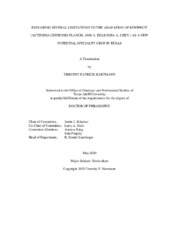| dc.description.abstract | The feasibility of commercial kiwifruit (Actinidia chinensis Planch. and A. deliciosa A. Chev.) production in Texas was investigated through three applied studies focusing on perceived key limitations to the adaptation of this crop. The response of two-year-old field-grown kiwifruit plants to early autumn frost was documented with respect to species, cultivar, and propagation method. A. deliciosa plants sustained significantly greater damage as compared to A. chinensis, with a propensity for basal injury and cracking proving to be unique to the former species. Among individual cultivars, A. deliciosa ‘AU Authur’ and ‘AU Fitzgerald’ exhibited the most severe damage, whereas A. chinensis Zespri Gold™ seedlings sustained the least.
A growth chamber-based study was conducted to compare floral and vegetative responses of two pistillate kiwifruit cultivars to continuously supplied winter chilling and warm temperature interrupted chilling at six weekly chilling increments using detached fruiting canes. A. deliciosa ‘AU Fitzgerald’ demonstrated evidence of chilling negation by warm temperature interruption as indicated by reduced floral activity at the two highest chilling levels imposed, whereas A. chinensis ‘AU Golden Dragon’ did not appear susceptible to chilling negation by intermittent warm winter temperatures, as are typical in southeastern Texas. Vegetative development showed no response to type of chilling.
The response of field-grown kiwifruit plants to contrasting soil pH conditions was evaluated to assess the effect of soil alkalinity on species, cultivar, and propagation method and to identify putative physiological and nutritional mechanisms involved. Soil alkalinity resulted in a greater incidence and intensity of visual chlorosis symptoms and reduced vigor, but was not associated with inhibited physiological responses such as photosynthesis. Chlorosis varied by species, propagation method, and cultivar, with more severe symptoms observed in A. chinensis, as a species and among clonally propagated plants. A. deliciosa ‘AU Authur’ and A. chinensis ‘AU Golden Dragon’ exhibited the least and most severe chlorosis symptoms, respectively among cultivars. Development of chlorosis was associated with inadequate leaf tissue concentrations of iron, manganese, and copper, with no indication of iron inactivation in shoot tissue. All factors assessed in this research are expected to pose serious limitations to the commercialization of this crop. | en |


